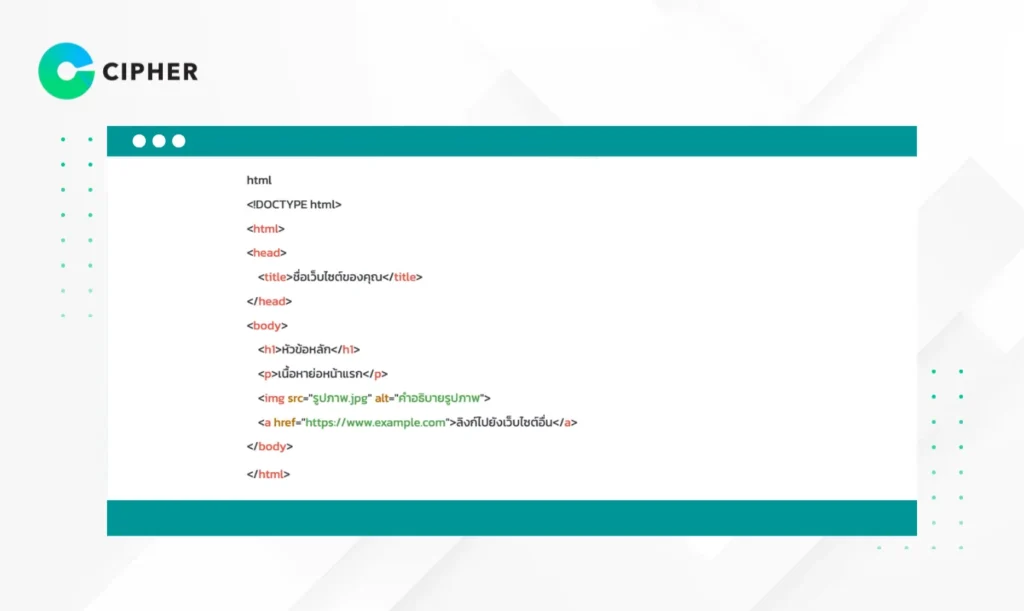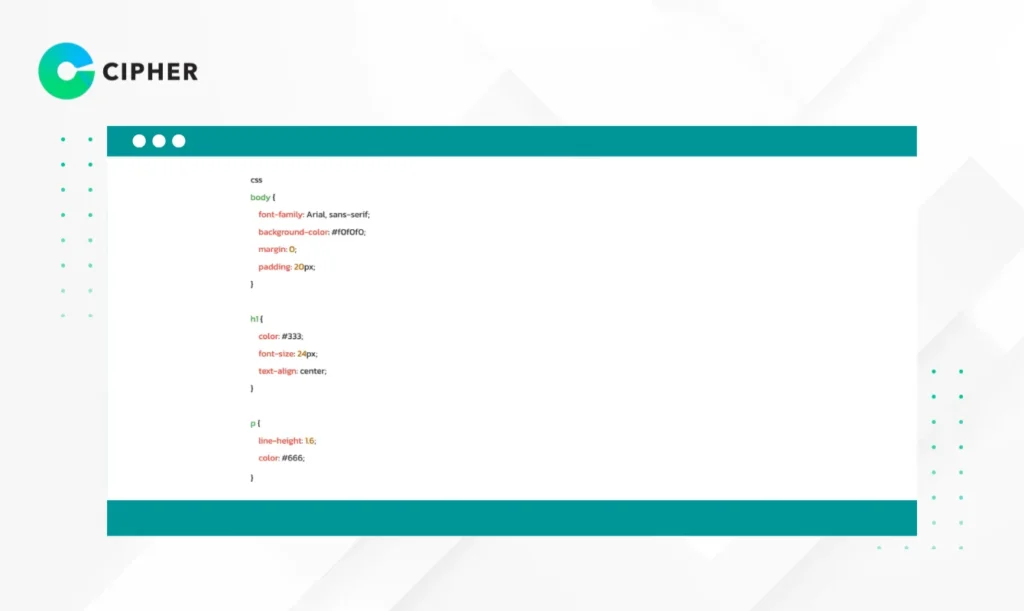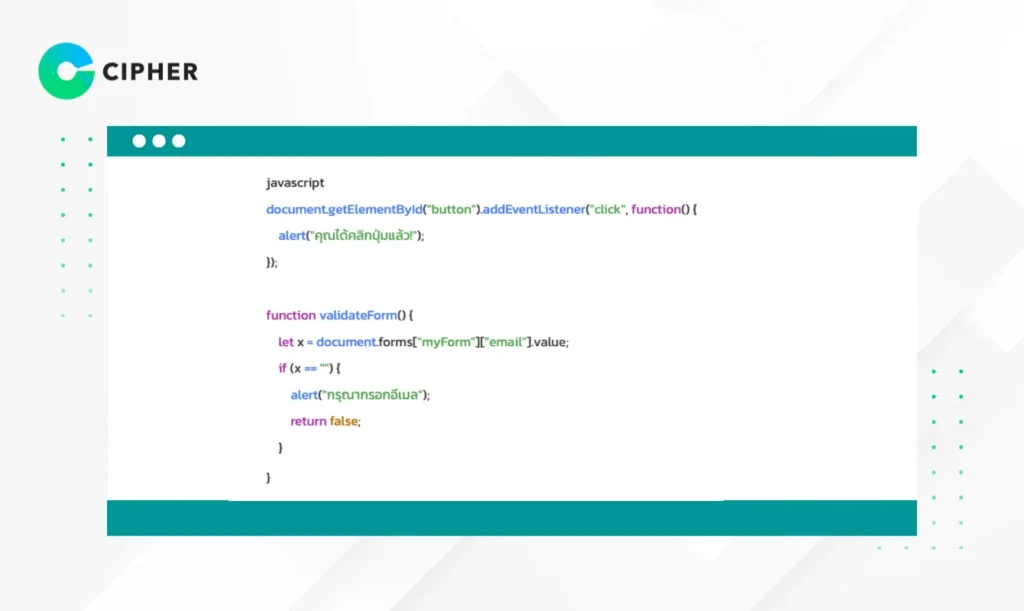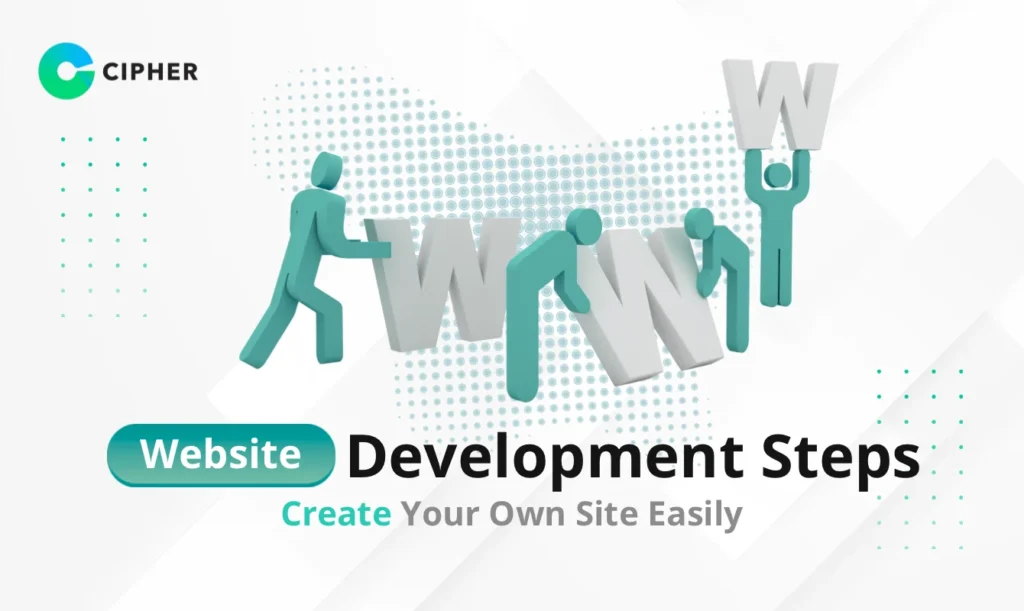Today, having your own website is essential for both businesses and individuals. Creating your own website can help save costs and give you the freedom to design according to your needs. In this article, CIPHER , a specialist in website design and development , will guide you through the steps of creating a website from scratch, including the languages used in website development, so you can efficiently build your own website.
Table of Contents
What Languages Are Used in Website Development?
Before starting to create a website , you should understand the basic languages used in website development, which consist of 3 main types:
1. HTML Language
HTML (Hyper Text Markup Language) is the most basic and important language in website creation. HTML functions to define the structure and content of web pages by using a tag system to control various displays on screen, such as headings, paragraphs, images, and links.
Example of basic HTML code:

2. CSS Language
CSS (Cascading Style Sheets) is a language used for decorating websites to make them attractive. CSS works together with HTML to define display styles such as colors, font sizes, spacing, borders, and the arrangement of various elements on the webpage.
Example of basic CSS code:

3. JavaScript Language
JavaScript is a programming language used to enhance user interaction with the website. This language helps make websites dynamic, responsive to user actions, and creates impressive experiences for website visitors.
JavaScript can be used to create various features such as:
- Form validation
- Animation effects
- Popups and modals
- Dynamic data loading without refreshing the page
Example of basic JavaScript code:

Steps for Website Development
1. Plan and Define Website Goals
Before starting to create a website, you should clearly define the objectives and goals of your website – what you want to create the website for, such as to present your work, sell products online, or share knowledge and information. Good planning will help make website development more directed and successful.
Additionally, you should create a sitemap to define the website structure – what pages it will have and how they will connect to each other, as well as layout the structure of each page. Good planning will help make website development more systematic and time-efficient.
2. Register a Domain and Rent Hosting Space
After planning, the next step is to register a domain and rent hosting space for your website. A domain name is your website name, such as www.yourwebsite.com, while hosting is the space for storing website files and all data.
Choosing a domain name should be memorable, relevant to your business or website content, and not too long. When selecting hosting, consider speed, stability, support for the technologies you want to use, and security services.
3. Start Coding or Use a CMS
After you have a domain and hosting, you can start creating your website. You have 2 options:
- Code it yourself – If you have knowledge of HTML, CSS, and JavaScript coding, you can create a website from scratch using a Text Editor like Visual Studio Code, Sublime Text, or Notepad++ to write code.
- Use a Content Management System (CMS) – If you don’t have coding knowledge, you can use a content management system like WordPress , Joomla, or Drupal, which allows you to create a website without writing code. CMS provides many themes and plugins to choose from, making website creation easier and faster.
Creating a website with a CMS is a popular choice for beginners because it’s easy to use and has a large community for support.
4. Design Website Pages
Website design is an important step to make your website beautiful and user-friendly. In this step, you should consider:
- Colors and fonts – Choose color schemes and font styles that match your brand or website theme
- Element arrangement – Position content, images, and buttons appropriately and user-friendly
- Responsive design – Make the website display well on all devices, including computers, tablets, and smartphones
- User Experience (UX) – Design for users to use the website conveniently and efficiently
Website development with good design will help create a great first impression for visitors and make them stay on your website longer.
5. Develop Features and Functions
After designing the website appearance, the next step is to develop various features and functions as needed, such as:
- Contact forms – For users to send messages to you
- Membership systems – For users to register and log in
- Search systems – For users to search for information on the website
- Payment systems – For websites selling products or services
- Social media sharing – For users to share content from your website to social media
Developing these features may require knowledge of JavaScript or using plugins in CMS. If you don’t have enough coding knowledge, you might consider using the services of a professional website developer for complex features.
Creating Your Own Website: How Much Does It Cost?
Creating a website yourself can save costs compared to hiring a website development company, but you still need to prepare a budget for various expenses:
- Website creation course costs – If you have no prior web development knowledge, you may need to invest in online courses or books to learn the necessary skills. Online courses range from thousands to tens of thousands of baht, depending on content and intensity.
- Server costs – For large websites with many users, you may need a Dedicated Server or Cloud Server, which costs more than general hosting. Starting prices range from thousands to tens of thousands of baht per month.
- Domain costs – Your website name, such as www.yourbusiness.com, costs about 300-1,000 baht per year, depending on the domain extension (.com, .net, .org, .co.th, etc.)
- Hosting costs – Space for storing website files costs about 1,000-5,000 baht per year for basic packages. The price increases with space size and performance requirements.
- Website security system costs – To protect against hacker attacks and malware, you may need to invest in security systems such as SSL Certificate, Firewall, or DDoS protection services, which cost about 1,000-5,000 baht per year.
- Template, Plugin, and add-on feature costs (for WordPress) – If you use WordPress to create your website, you may need to buy premium themes and plugins to add functions and beauty to your website. Starting prices from 500 baht and up per theme or plugin.
- Graphic design and illustration costs – You may need to hire a graphic designer or buy images from Stock Photo websites for use on your website. Prices depend on quality and number of images required.
- Labor and time costs – Even though you’re creating the website yourself, you still need to invest time in learning and developing the website, which can be a high cost if you have a regular job or business to manage.
When all expenses are combined, creating a website yourself may have an initial cost starting from 5,000 baht up to hundreds of thousands of baht, depending on the size and complexity of the website.
Self-Created Website vs. Ready-Made Website: Which is Better?
The decision to create your own website or use a ready-made website depends on your needs, skills, and resources. Let’s look at the advantages and limitations of each method.
Self-Created Website
Advantages:
- Freedom to design and develop the website as desired
- Ability to customize functions and features without limitations
- No monthly or annual fees for platforms
- Suitable for complex websites or those requiring specialized functions
- Better control over security and performance
Limitations:
- Requires knowledge and coding skills
- Takes more development time
- Must maintain and update the system yourself
- May have high costs in developing complex features
- Responsible for security and data backup
Ready-Made Website
The advantages and limitations of using a website builder are as follows:
Advantages:
- Easy to use, no coding knowledge required
- Create websites quickly
- Many templates and themes to choose from
- Updates and security system managed by the service provider
- Basic features ready to use immediately
- Suitable for beginners or small businesses
Limitations:
- Limited customization and design options
- May have monthly or annual fees
- May have space and resource limitations
- Not suitable for websites requiring complex or specialized functions
- May have problems migrating data if you want to change service providers
If you have coding knowledge or are willing to learn, creating your own website will give you more freedom and flexibility. But if you need speed and ease of use, a ready-made website might be a better choice.
Differences Between Self-Created Website vs. Hiring a Website Development Company
If you don’t have time or skills to create a website yourself, hiring a website development company is another option. The differences between the two methods are:
Self-Created Website:
- Saves hiring costs
- Flexibility in editing and improving
- Requires time to learn and develop
- Must fix problems and maintain the system yourself
- Quality depends on your skills and experience
- Suitable for those with knowledge or ready to learn IT
Hiring a Website Development Company:
- Higher hiring costs
- Get a quality and standard website
- Saves development time
- Has a professional team for consulting and problem-solving
- Includes after-sales services such as website maintenance and updates
- Suitable for businesses needing professionalism and no time to maintain the website themselves
The choice between these two methods depends on your budget, time, skills, and business needs. If you want a high-quality website and don’t have time to learn and develop, hiring a website development company might be a more worthwhile option in the long run.
Create a Professional Business Website with Design and Development Services from CIPHER!
If you want to create a high-performance website but don’t have time or skills to create it yourself, CIPHER is ready to provide comprehensive website design and development services.
CIPHER is a leading IT Solution and Digital Marketing company with experience developing websites for leading businesses in Thailand. With a high-quality and experienced team, CIPHER can create websites that precisely meet your business needs.
CIPHER’s services cover:
- Website design and development according to requirements
- E-Commerce system development
- SEO to rank your website on Google
- Mobile application development
- Digital Marketing consulting
Choosing CIPHER’s services will help you get a high-quality website, practically usable, and ready to support business growth in the future, without worrying about creating a website yourself which requires a lot of time and resources.
Conclusion
Frequently Asked Questions (FAQ)
Do I need prior coding knowledge?
How long does it take to create a website?
Depends on size and complexity, such as:
- Small website: 1-2 weeks
- Medium website: 1-2 months
- Large website/E-Commerce: 3-6 months Beginners should plan extra time for additional learning.
What tools are recommended for beginners?
Website creation tools for beginners that are easy to use, such as:
- Text Editor: Visual Studio Code, Sublime Text
- CMS: WordPress, Joomla
- Ready-made website: Wix, Shopify
- Learning resources: W3Schools, Codecademy, freeCodeCamp





